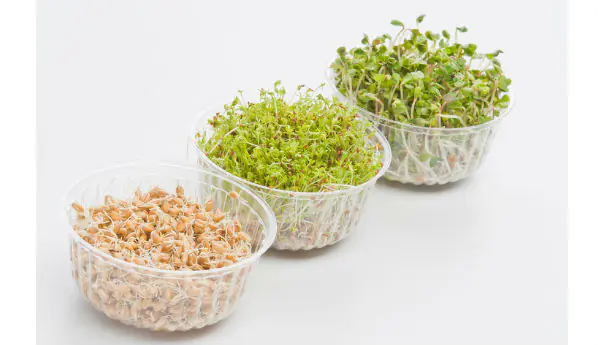You've probably noticed on supermarket shelves small containers with sprouts of all kinds of vegetables, cereals and salads. These are mini-greens - incredibly healthy products that you can germinate even at home. Why these small “green spaces” are so useful and what dishes they are used in - read below.
The content of vitamins and minerals in mini-greens is off the charts. All of them are an excellent source of vitamin A, vitamins B, C, D, E, K, as well as minerals (calcium, magnesium, phosphorus, potassium and silicon). Oat sprouts, for example, have 500% more vitamin B6 and 1350% more vitamin B2 than oatmeal!
Mini-greens - namely fresh young sprouts - are a very popular ingredient for salads, sandwiches, soups and oriental dishes. They are also good with eggs (especially in omelettes), as well as with potatoes, for example, with potato pancakes. Sprouts add a subtle crunch and texture to any dish. They are mainly eaten raw, but they are also suitable for cooking - heat treatment should not last more than 30-45 seconds so that the mini-greens do not lose their charm. Moreover, mini-greens are ideal for preparing vitamin cocktails in a blender and baking homemade bread.
Wheat, rye, oats, lentils, peas, chickpeas, golden beans, mung beans, soybeans, alfalfa, pumpkin, sunflower, corn, radishes, fennel, broccoli and other types of cabbage are suitable for sprouting. But there are also the most popular and most common ones.
Soy. Its delicate light sprouts are most often added to dishes as decoration, since they cannot boast of a particularly bright taste. They are ideal for quick frying, especially since they are not suitable for food in their raw form. To add soy sprouts to salads, you need to blanch them for at least 30 seconds - this will make them tastier.
Peas. Juicy, fresh and very tasty sprouts! You can add them anywhere, but, as in the case of soybeans, pea sprouts should be doused with boiling water before using.
Alfalfa is a particularly frequent guest in salads, sometimes simply as a leaf vegetable. Alfalfa sprouts taste like green peas.
Lentils. Very small sprouts with a delicate taste. They are eaten raw, in salads, sandwiches, and also boiled and added to a variety of dishes, including when baking bread.
Mung beans (mung beans). One of the many varieties of beans, the sprouts of which are most often confused and passed off as soybeans. But the difference is that young mung bean sprouts can – and should! - eat raw. They can just as easily be added to stews or woks - just at the last minute, along with the greens, so they don't lose their appeal and crunch.
Radish. Small green sprouts, thanks to their pungent taste, are a piquant addition to salads made from raw or fried vegetables, to sandwiches or meat dishes.
Broccoli. Small, dark green and slightly hot. But very tasty! They are eaten both raw and boiled. They turn out especially well if you steam them. The taste is a little reminiscent of alfalfa sprouts, but the application is unlimited: salads, sandwiches, first and second courses.
Kohlrabi. The tender green sprouts are eaten raw. Kohlrabi has a humorous nickname - “lemon from the garden”, since it contains more vitamin C than many fruits. So it’s not difficult to guess that this mini-green is full of benefits and vitamins!
Fennel. Its sprouts are an ideal addition to white fish dishes. And in general, to any dishes to which it is customary to add dill.
Sunflower. Giants among all other mini-greens! Very tasty, tender and especially useful for children.
Kaiware (daikon sprouts). They are especially popular in Japanese cuisine. It’s not easy to find them here, but in the Land of the Rising Sun they are sold in



